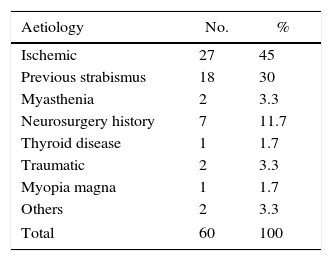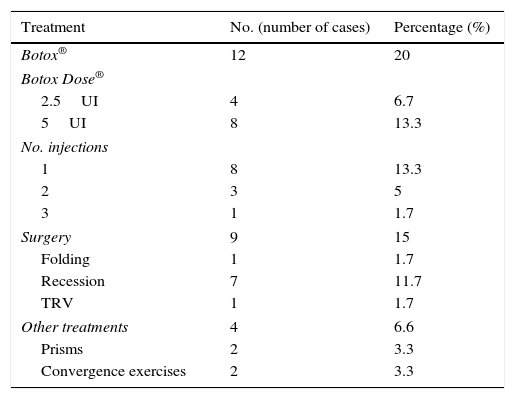To study the causes, diagnosis and treatment in a case series of binocular diplopia.
Material and methodA retrospective chart review was performed on patients seen in the Diplopia Unit of a tertiary center during a one-year period. Diplopia was classified as: acute ≤1 month since onset; subacute (1–6 months); and chronic (>6 months). Resolution of diplopia was classified as: spontaneous if it disappeared without treatment, partial if the course was intermittent, and non-spontaneous if treatment was required. It was considered a good outcome when diplopia disappeared completely (with or without treatment), or when diplopia was intermittent without significantly affecting the quality of life.
ResultsA total of 60 cases were included. The mean age was 58.65 years (60% female). An acute or subacute presentation was observed in 60% of the patients. The mean onset of diplopia was 82.97 weeks. The most frequent aetiology was ischemic (45%). The most frequent diagnosis was sixth nerve palsy (38.3%), followed by decompensated strabismus (30%). Neuroimaging showed structural lesions in 17.7% of the patients. There was a spontaneous resolution in 28.3% of the cases, and there was a good outcome with disappearance of the diplopia in 53.3% at the end of the study.
ConclusionsThe most frequent causes of binocular diplopia were cranial nerve palsies, especially the sixth cranial nerve, followed by decompensated strabismus. Structural lesions in imaging tests were more than expected. Only one third of patients had a spontaneous resolution, and half of them did not have a good outcome despite of treatment.
Estudiar las causas, el diagnóstico, el tratamiento y los resultados de una serie de casos con diplopía binocular.
Material y métodoEstudio retrospectivo de pacientes referidos a consulta de diplopía del servicio de oftalmología durante un año. La diplopía se clasificó en aguda ≤1mes desde su inicio, subaguda (1-6 meses) y crónica (>6). La resolución de la diplopía se consideró espontánea si desaparecía sin necesidad de tratamiento, parcial cuando quedaba intermitente y no resolución espontánea cuando se necesitó tratamiento. Se consideró buen resultado cuando desaparecía por completo la diplopía con/sin tratamiento o era intermitente sin afectar a la calidad de vida del paciente.
ResultadosUn total de 60 casos fueron incluidos. La edad media fue 58,65 años (60% mujeres). El 60% fueron agudas o subagudas. La evolución media de la diplopía fue 82,97 semanas. La etiología más frecuente fue isquémica en el 45%. La parálisis del sexto nervio fue el diagnóstico más frecuente: 38,3%, después estrabismos descompensados: 30%. Se encontraron lesiones en las pruebas de neuroimagen en un 17,7%. La resolución espontánea se produjo en un 28,3%. El 53,3% presentó un buen resultado con desaparición de la diplopía al final del estudio.
ConclusionesLas causas más frecuentes de diplopía binocular fueron las parálisis de los nervios craneales, especialmente del vi, seguidas de estrabismos descompensados. Se encontraron lesiones estructurales en las pruebas de imagen en un porcentaje importante. Solo en un tercio de los pacientes la diplopía se resolvió espontáneamente y la mitad tuvo un mal resultado a pesar del tratamiento.











